Education
Chevron Program Funds 1,091 East Bay Classroom Projects in Fall
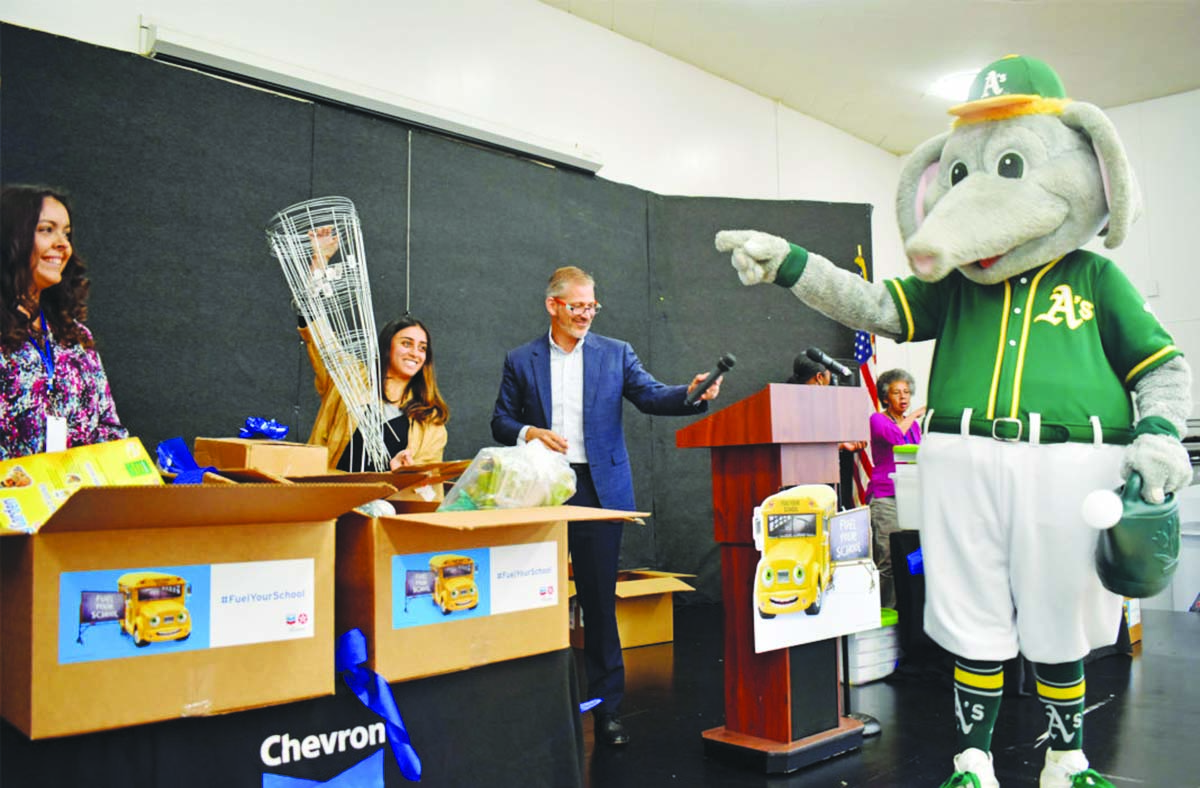
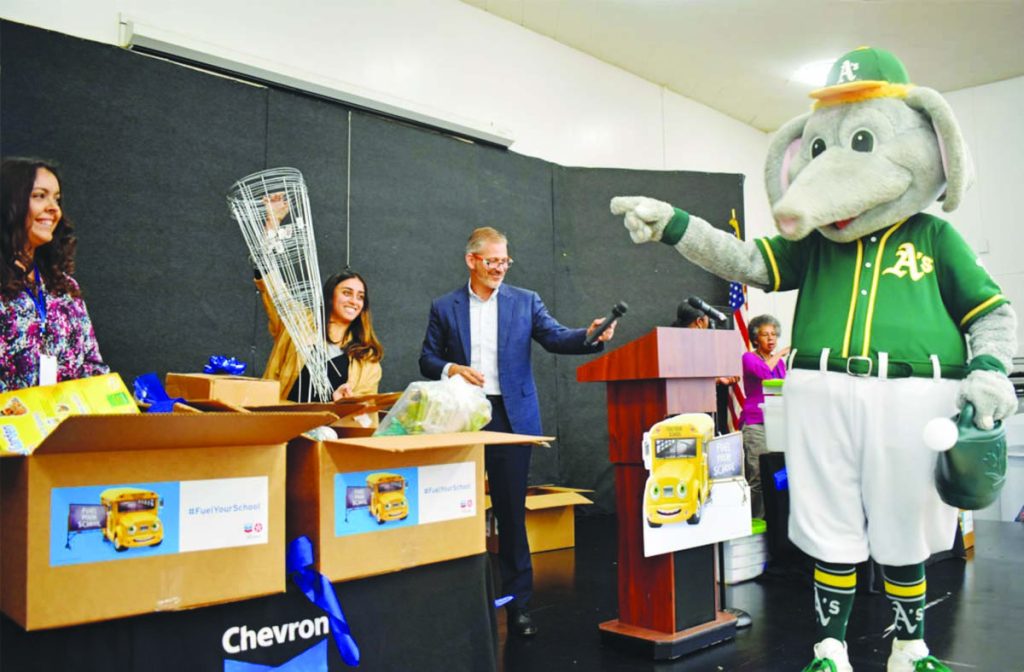
The Chevron Fuel Your School program visited Stege Elementary in October to encourage teachers in West County and beyond to make funding requests for classroom projects, particularly in STEM subjects, via DonorsChoose.org.
The Chevron Fuel Your School program visited Stege Elementary in October to encourage teachers in West County and beyond to make funding requests for classroom projects, particularly in STEM subjects, via DonorsChoose. org.
When it comes to funding classroom projects, local schools are continuing to get a lot of mileage out of the Chevron Fuel Your School program.
In Contra Costa and Alameda counties, 1,091 classroom projects, about half focused on the subjects of science, technology, engineering and math (STEM), were funded this fall through the program, the com¬pany announced today.
Fuel Your School runs through the month of October. Every time consumers filled up with eight or more gallons at participating Chevron or Texaco stations, Chevron donates $1, totaling $1 million. That money then goes to fund requests by teachers on DonorsChoose.org for classroom tools and materials.
In Richmond, 25 schools received Fuel Your School program funding, averaging just over $39,000 per school and impacting 3,033 students. Eleven projects funded within the city of Richmond involved STEM subjects, such as Stege Elementary, where a fifth-grade teacher had a BrickLAB STEM Foundations set to help students learn through building, and where a middle-school teacher received all the laboratory equipment neces¬sary for an Anatomy of an Earthworm hands-on learning course.
In terms of the West Contra Costa Unified School District, 44 schools received funding, impacting 4,802 students and launching 15 STEM projects.
Since Chevron launched Fuel Your School in 2010, the program has generated $8.88 million for schools in Alameda and Contra Costa counties. The program also exists in 16 other communities in the U.S., generating in total $5.74 million this fall for classroom projects, benefitting nearly 790,700 stu We are proud to support our passionate local teachers, especially in their efforts to educate and inspire young people in STEM subjects,” said Lily Rahnema, community engagement manager with Chevron Richmond.
Matt Duffy, superintendent for WCCUSD, says the donations are very helpful to educators working on tight budgets.
“These donations, especially when budgets are tight, have helped our hard-working and dedicated educators provide compelling classroom instruction, which is critical for us to keep our students focused and engaged,” Duffy said during a Fuel Your School event in Richmond earlier this month.
Activism
LIVE! — TOWN HALL ON RACISM AND ITS IMPACT — THURS. 11.14.24 5PM PST
Join us for a LIVE Virtual Town Hall on the Impact of Racism hosted by Post News Group Journalist Carla Thomas and featuring Oakland, CA NAACP President Cynthia Adams & other Special Guests.
Thursday, November 14, 2024, 5 p.m. – 6:30 p.m. PST
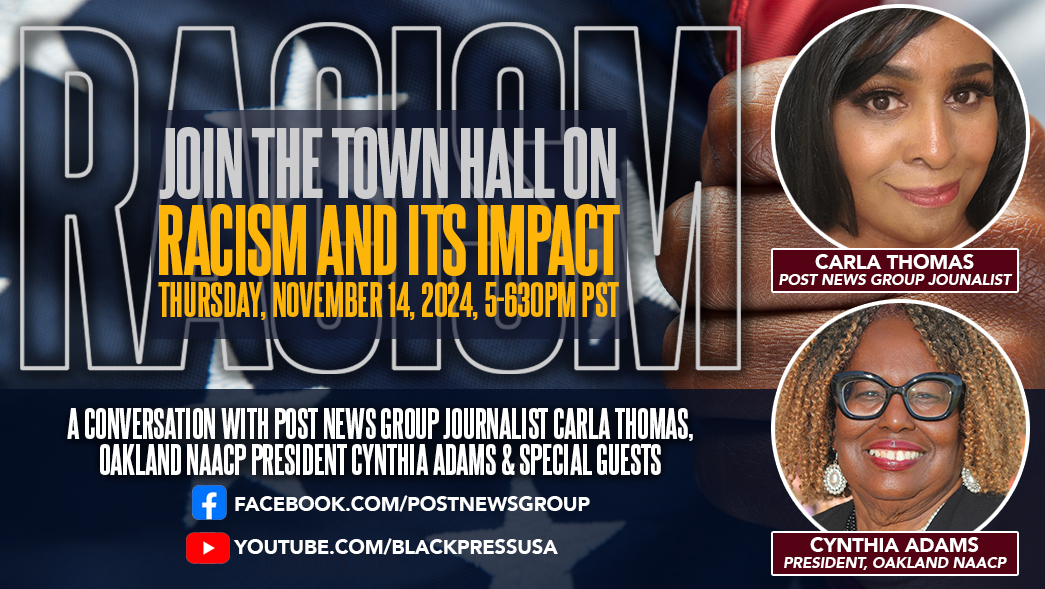
Join us for a LIVE Virtual Town Hall on the Impact of Racism hosted by Post News Group Journalist Carla Thomas and featuring Oakland, CA NAACP President Cynthia Adams & other Special Guests.
Thursday, November 14, 2024
5 p.m. – 6:30 p.m. PST
Discussion Topics:
• Since the pandemic, what battles have the NAACP fought nationally, and how have they impacted us locally?
• What trends are you seeing concerning Racism? Is it more covert or overt?
• What are the top 5 issues resulting from racism in our communities?
• How do racial and other types of discrimination impact local communities?
• What are the most effective ways our community can combat racism and hate?
Your questions and comments will be shared LIVE with the moderators and viewers during the broadcast.
STREAMED LIVE!
FACEBOOK: facebook.com/PostNewsGroup
YOUTUBE: youtube.com/blackpressusatv
X: twitter.com/blackpressusa
Art
Brown University Professor and Media Artist Tony Cokes Among MacArthur Awardees
When grants were announced earlier this month, it was noted that seven of the 22 fellows were African American. Among them are scholars, visual and media artists a poet/writer, historian, and dancer/choreographer who each receive $800,000 over a five-year period to spend as they see fit. Their names are Ruha Benjamin, Jericho Brown, Tony Cokes, Jennifer L. Morgan, Ebony G. Patterson, Shamel Pitts, Jason Reynolds, and Dorothy Roberts. This is the third in the series highlighting the Black awardees.

Special to The Post
When grants were announced earlier this month, it was noted that seven of the 22 fellows were African American. Among them are scholars, visual and media artists a poet/writer, historian, and dancer/choreographer who each receive $800,000 over a five-year period to spend as they see fit. Their names are Ruha Benjamin, Jericho Brown, Tony Cokes, Jennifer L. Morgan, Ebony G. Patterson, Shamel Pitts, Jason Reynolds, and Dorothy Roberts. This is the third in the series highlighting the Black awardees. The report below is excerpted from the MacArthur Fellows web site.
Tony Cokes
Tony Cokes, 68, is a media artist creating video works that recontextualize historical and cultural moments. Cokes’s signature style is deceptively simple: changing frames of text against backgrounds of solid bright colors or images, accompanied by musical soundtracks.
Cokes was born in Richmond, Va., and received a BA in creative writing and photography from Goddard College in 1979 and an MFA from Virginia Commonwealth University in 1985. He joined the faculty of Brown University in 1993 and is currently a professor in the Department of Modern Culture and Media.
According to Wikipedia, Cokes and Renee Cox, and Fo Wilson, created the Negro Art Collective (NAC) in 1995 to fight cultural misrepresentations about Black Americans.[5]
His work has been exhibited at national and international venues, including Haus Der Kunst and Kunstverein (Munich); Dia Bridgehampton (New York); Memorial Art Gallery University of Rochester; MACRO Contemporary Art Museum (Rome); and the Carpenter Center for the Visual Arts (Harvard University), among others.
Like a DJ, he samples and recombines textual, musical, and visual fragments. His source materials include found film footage, pop music, journalism, philosophy texts, and social media. The unexpected juxtapositions in his works highlight the ways in which dominant narratives emerging from our oversaturated media environments reinforce existing power structures.
In his early video piece Black Celebration (A Rebellion Against the Commodity) (1988), Cokes reconsiders the uprisings that took place in Black neighborhoods in Los Angeles, Detroit, Newark, and Boston in the 1960s.
He combines documentary footage of the upheavals with samples of texts by the cultural theorist Guy Debord, the artist Barbara Kruger, and the musicians Morrisey and Martin Gore (of Depeche Mode).
Music from industrial rock band Skinny Puppy accompanies the imagery. In this new context, the scenes of unrest take on new possibilities of meaning: the so-called race riots are recast as the frustrated responses of communities that endure poverty perpetuated by structural racism. In his later and ongoing “Evil” series, Cokes responds to the rhetoric of the Bush administration’s “War on Terror.”
Evil.16 (Torture.Musik) (2009–11) features snippets of text from a 2005 article on advanced torture techniques. The text flashes on screens to the rhythm of songs that were used by U.S. troops as a form of torture.
The soundtrack includes Metallica’s “Enter Sandman” and Britney Spears’s “… Baby One More Time,” songs known to have been played to detainees at deafening decibel levels and on repeated loops. The dissonance between the instantly recognizable, frivolous music and horrifying accounts of torture underscores the ideological tensions within contemporary pop culture.
More recently, in a 2020 work entitled HS LST WRDS, Cokes uses his pared-down aesthetic to examine the current discourse on police violence against Black and Brown individuals. The piece is constructed around the final words of Elijah McClain, who was killed in the custody of Colorado police. Cokes transcribes McClain’s last utterances without vowels and sets them against a monochromatic ground. As in many of Cokes’s works, the text is more than language conveying information and becomes a visualization of terrifying breathlessness. Through his unique melding of artistic practice and media analysis, Cokes shows the discordant ways media color our understanding and demonstrates the artist’s power to bring clarity and nuance to how we see events, people, and histories.
California Black Media
On Your November Ballot: Prop 2 Seeks to Modernize Public Education Facilities
Proposition 2 would authorize the state to issue $10 billion in bonds with $8.5 billion dedicated to elementary and secondary educational facilities and $1.5 billion for community college facilities. If approved, the proposition will make changes to the formula used to determine the amount each district is required to contribute to be eligible to receive state funding from the bond revenue. It would also require the state government to cover between 50 and 55% of construction project costs and 60 and 65% of modernization project costs.

By Edward Henderson, California Black Media
Proposition 2 would authorize the state to issue $10 billion in bonds with $8.5 billion dedicated to elementary and secondary educational facilities and $1.5 billion for community college facilities.
If approved, the proposition will make changes to the formula used to determine the amount each district is required to contribute to be eligible to receive state funding from the bond revenue. It would also require the state government to cover between 50 and 55% of construction project costs and 60 and 65% of modernization project costs.
Supporters argue that the money is critical for making safety improvements in schools, as well as modernizing science labs, performing arts spaces and kindergarten classrooms. School districts in lower-income areas have no other way to pay for these improvements.
According to the Public Policy Institute of California, 38% of students attend schools that don’t meet the state’s minimum safety standards. The research shows that schools with sub-standard facilities tend to have students with lower attendance rates, lower morale and lower overall academic performance.
California Black Media spoke with a Los Angeles Unified School District (LAUSD) spokesperson on why she believes it should be a YES vote on Prop 2.
“Measure US, Los Angeles Unified’s Local Public Schools Safety and Upgrades Measure on the November ballot would provide $9 billion to upgrade Los Angeles public schools for safety and 21st century student learning and college and career preparedness. The average annual cost to property owners is estimated at 2.5 cents per $100 of assessed (not market) property value. The Los Angeles Unified Board of Education adopted a Resolution on October 22 to support Los Angeles Unified’s Measure US, and State Propositions 2 and 4,” the spokesperson said.
Opponents argue that the state should include school repairs in its regular budget instead of putting the burden on taxpayers. Opponents also argue that the proposition would not directly impact students. The Howard Jarvis Taxpayers Association is on record as one of the organizations opposing the proposition.
“Proposition 2 is $10 billion of bonds, new state debt, to pay for school facilities. It is almost certain to result in higher property tax bills, because school districts must provide a ‘local match’ of funds in order to receive money from the Prop. 2 state bonds. That will lead to districts issuing new local school bonds, which are paid for by adding new charges to property tax bills,” said Jarvis.
Opponents also have voiced concerns about what they view as an inequitable distribution of funds. They believe that lower-income school districts should receive a greater share of the state’s sliding scale for matching funds.
“Enrollment is declining in both K-12 district schools and community colleges and the declines are projected to continue. But Proposition 2 commits California to pay an estimated $18 billion, including interest, for school buildings that may not even be necessary. Vote no on proposition 2.”
A “yes” vote gives approval to the state to issue $10 billion in bonds to fund construction and modernization of public education facilities.
A “no” vote will prohibit the state from issuing $10 billion in bonds to fund construction and modernization of public education facilities.
-

 Alameda County3 weeks ago
Alameda County3 weeks agoAlameda County District Attorney Pamela Price Announces $7.5 Million Settlement Agreement with Walmart
-

 Activism2 weeks ago
Activism2 weeks ago‘Jim Crow Was and Remains Real in Alameda County (and) It Is What We Are Challenging and Trying to Fix Every Day,’ Says D.A. Pamela Price
-
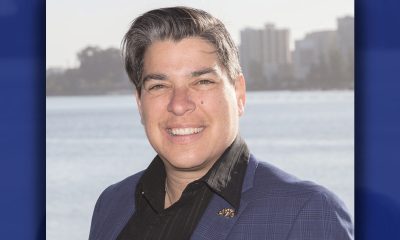
 Activism4 weeks ago
Activism4 weeks agoOP-ED: Hydrogen’s Promise a Path to Cleaner Air and Jobs for Oakland
-

 Bay Area3 weeks ago
Bay Area3 weeks agoIn the City Attorney Race, Ryan Richardson Is Better for Oakland
-

 Bay Area4 weeks ago
Bay Area4 weeks ago2024 Local Elections: Q&A for Oakland Unified School Candidates, District 3
-

 Activism2 weeks ago
Activism2 weeks agoOakland Post: Week of October 30 – November 5, 2024
-
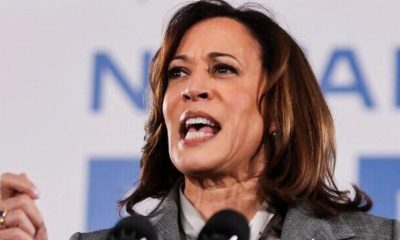
 Business4 weeks ago
Business4 weeks agoHarris Promises 1 Million Forgivable Loans for Black Businesses
-

 Business4 weeks ago
Business4 weeks agoStudy Confirms California’s $20/Hour Fast Food Wage Raises Pay Without Job Losses















































